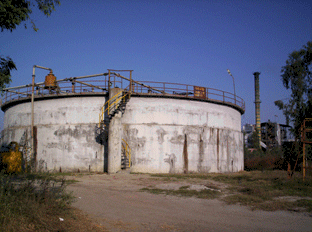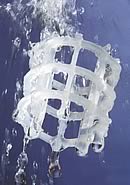

Trickling Filters An OnLine Primer Need to know more? Send us an email or feel free to search our online series with our give away search engine: |
While trickling filters have seen their market share increase so to speak, easily or readily transferable design/bioengineering formulas have yet to arrive if at all. Let's discuss each nuance separately.as limitations arise because much of the available material/equations/ models say derives from either
- low strength, municipal type contexts
- installations or designs using just one type of media, say either cross-flute OR vertical-flute media, and/or
- general problem/solution formulations focusing or addressing soluble or dissolved biological oxygen demand, sBOD for short.
We're left sort of unaided when it comes to address high strength, mixed media, lump BOD/COD all at the same time scenarios.
For municipal wastewater, many reputable media vendors provide some sort of computerized/courtesy design/ballpark sizing based on modified Velz formula variants. It is also very common that they specify minimum and maximum wetting rates, basically hydraulic loading ranges 0.25 - 0.75 gpm/sq.ft. being possible figures, as well as maximum organic load per cubic feet, say 50 lbBOD/day per 1,000 cu.ft. Taking this into account and sticking to predominantly/solely municipal wastewater trickling filters find their way in many engineering reports. Even then, things can get tricky.
One can seldom can apply equations developed for municipal wastewaters (ie the Velz equation for TFs) to industrial wastewaters. The reason is that the sizing and performance equations for municipal systems almost always are related to hydraulic factors, ie HRT, wetting rates, etc, while industrial systems are almost always load controlled (ie SRT, organic loading rate, etc.). The problem with trickling filters is that when even treating municipal wastewaters, say at 1 kg/m3/day, the BOD is spread out from around 400 mg/L at the top to 25+/- at the bottom of the tower. With industrial wastewaters for the same loading rate, the BOD at the top of the reactor is substantially higher even with direct recycle, so that oxygen transfer limits are reached rapidly in the top few feet or meters of depth. Under these conditions, excessive growth occurs with associated plugging and odor production, usually occur.
Assuming media with a thick biofilm of 3-4 mm( including the water) it will have a weight of above 500 kg/m³. On 6 meters the bottom layer will have to sustain a weight of 3 tonnes! Media failure is around the corner.
Since the TF is open at the top, any recirculation pump will have to overcome the entire elevation head plus friction headloss for the influent and the recycle streams. So the elevation head is the height from the bottom of the sump for the recycle pump to the top of the highest point in the TF distributor.
When the recycle ratio exceeds 3:1, the cost of pump power tends to negate the inherent advantages of a trickling filter.
Roughing filters are trickling filters employing relatively coarse media and operated at high rates to perform aerobic biological preliminary treatment, e.g. target soluble BOD 50-80 % removals.
For the purpose of rough calculations we can, whatever the units used, and using say COD as constituent, combine these two formulas:
Yn = Yo * ( 1 + 0.2 * Kd * SRT) / ( 1 + 1.2 * Kd * SRT)
Yn = bugs in tank * 100 / ( SRT * kgCOD/day * COD removal points)
Thus we have
bugs in tank * 100 / ( SRT * kgCOD/day * COD removal points) = Yo * ( 1 + 0.2 * Kd * SRT) / ( 1 + 1.2 * Kd * SRT)
Solving for one of the SRT we get the coveted iteration formula:
SRT = bugs in tank * 100 * ( 1 + 1.2 * Kd * SRT) / ( kgCOD/day * COD removal points * Yo * ( 1 + 0.2 * Kd * SRT) )
From now on it's just a matter of allowing Excel to perform circular reference iterations (you may have to enable this setting in your Excel version).
For those unfamiliar with iterative methods (a numerical analysis classic) one way to find a root of an equation is to solve for the variable and give iterative methods a try.
Were we to find a root for say
a * x^2 + b * x = (a * x + b) * x = 0
One possible iteration formula to try could be solving for x as follows:
x = 1 / (a * x + b)
While it may seem laughable to do it for this case the truth is that it works great for the not so immediate cases. With minor tweaks it can be used for UASBs, HAFs, BVFs, BNR TFs of all sorts.
At 115°F the bacteria will still grow, but they will not stick to the surface of the media. So, until the cooling tower/media has dropped the temperature to below 105°F or so at least, the cooling tower would not function as a biological treatment unit. An explorable path would be to handle it as a cooling tower application and then consider a trickling filter after the water is below 95°F. The trickling filter would be large - many industries and in particular most paper mills have huge lagoons for treating these wastewaters.
